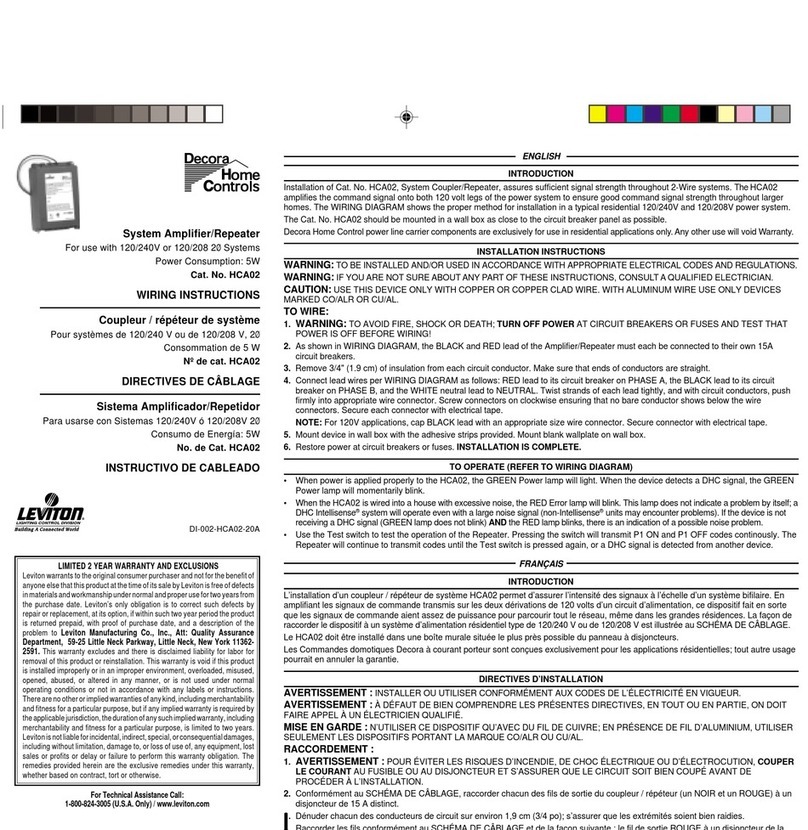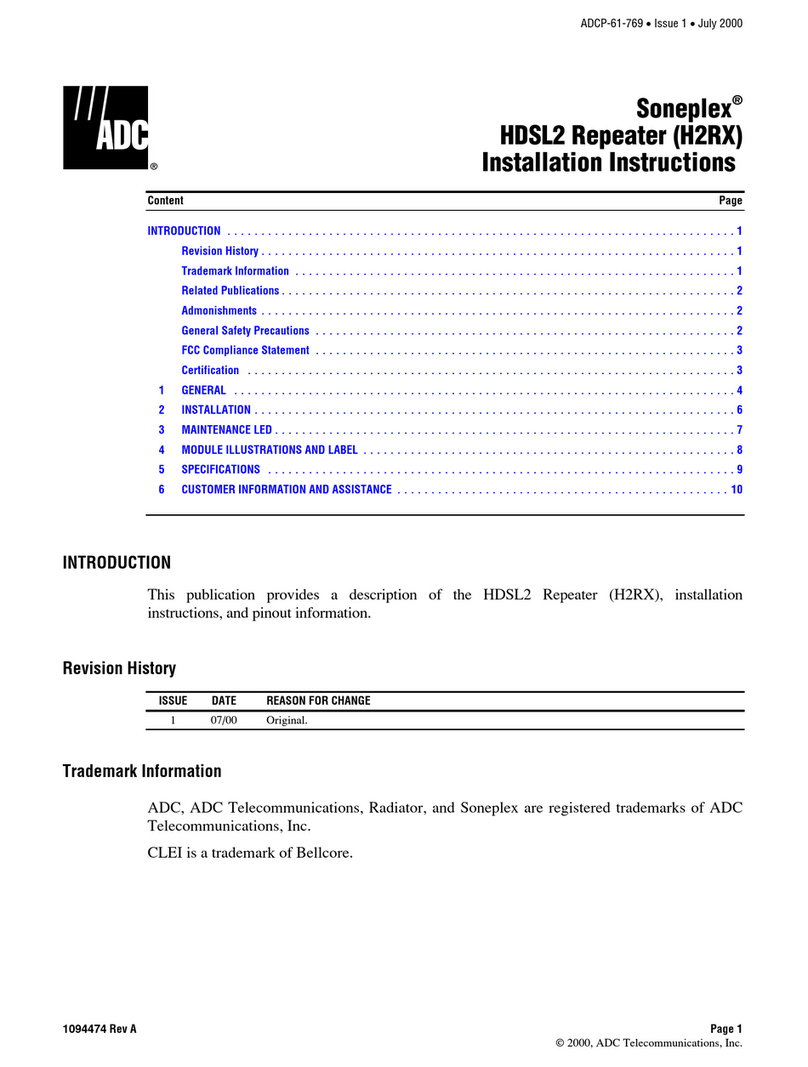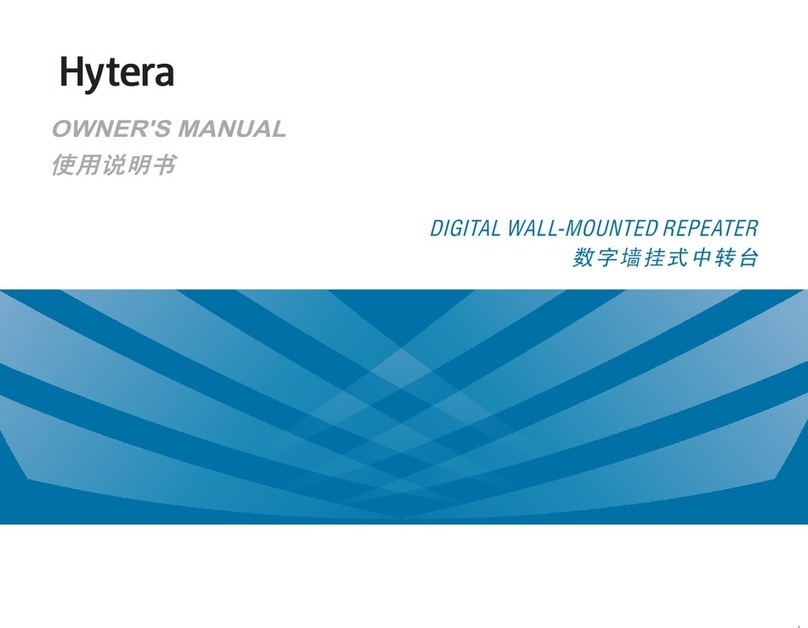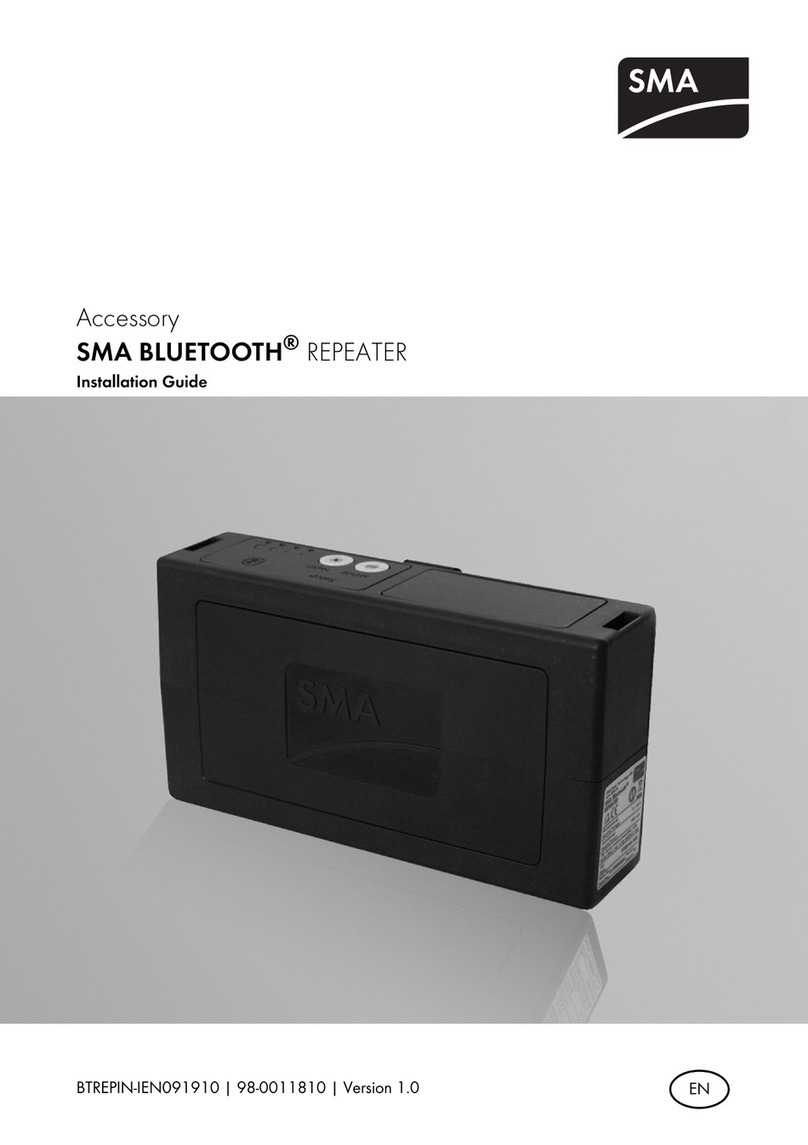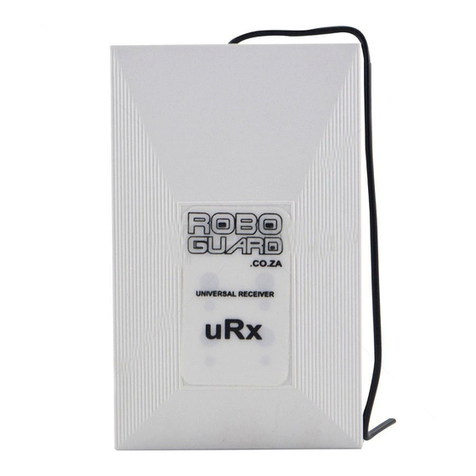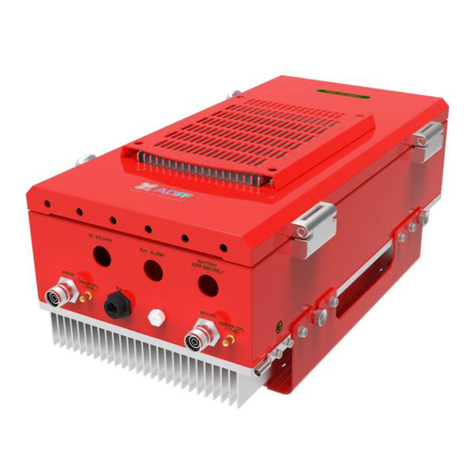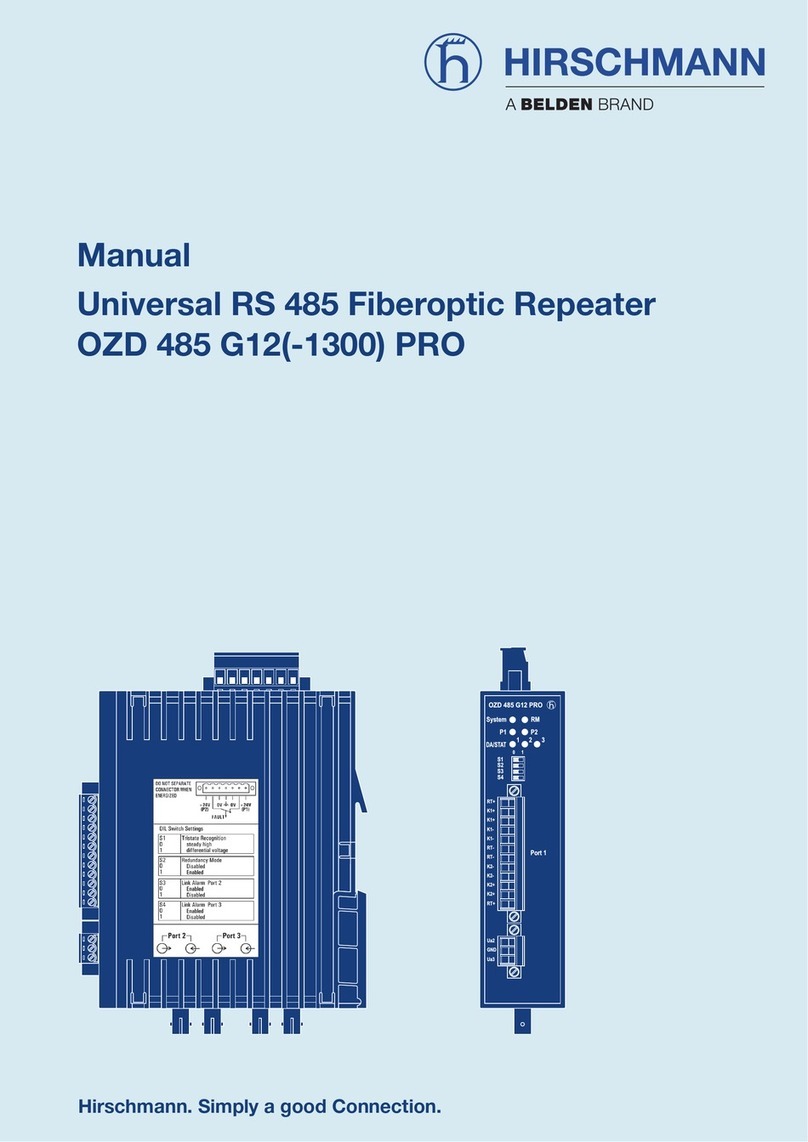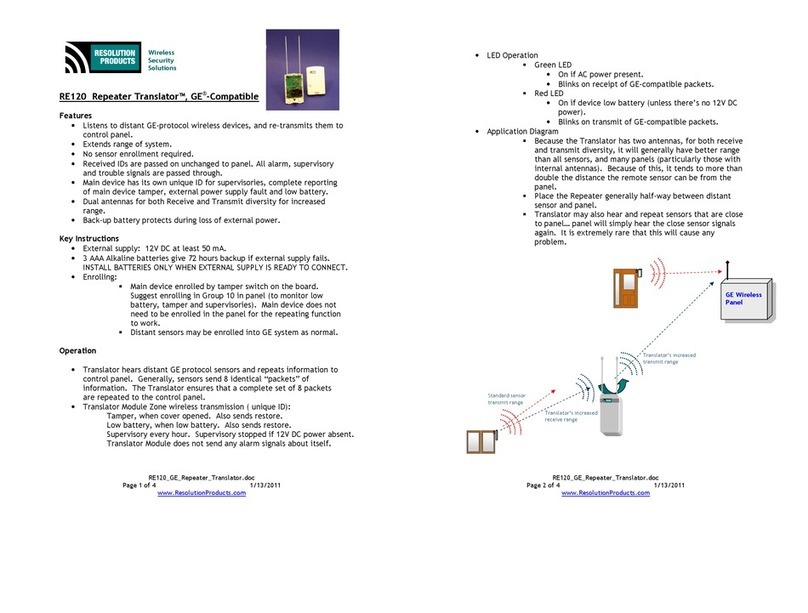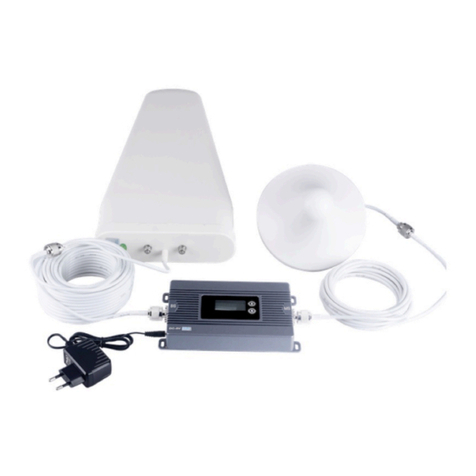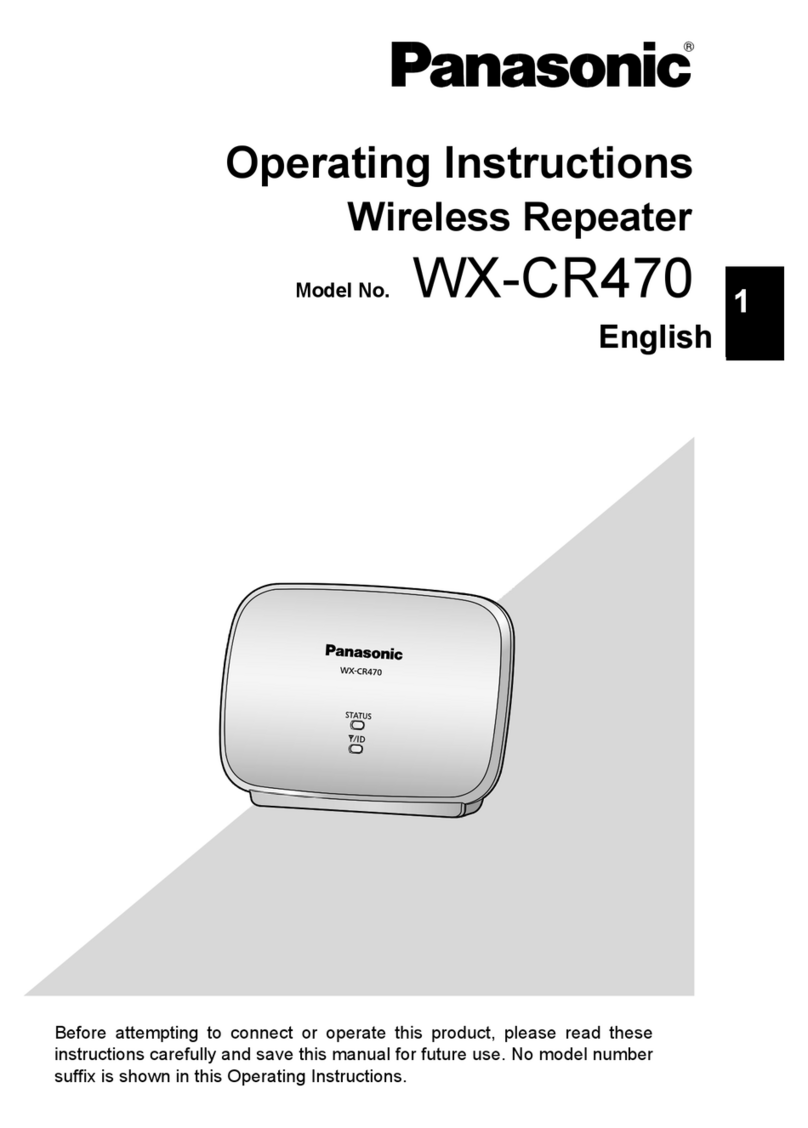aci RR2552B Installation instructions

Automation Components, Inc.
2305 Pleasant View Road | Middleton, WI 53562
Phone: 1-888-967-5224 | Website: workaci.com
Page 1
Version: 7.0
I0000666
RR2552 SPREAD SPECTRUM
REPEATER
Installation & Operation Instructions
Phone: 1-888-967-5224
Website: workaci.com
DETERMINING REPEATER LOCATION
Remove the battery from the sensor that is not connected to the receiver, and press the yellow trasmit
button. This dissipates any capacitive charge left in the sensor. Leave the sensor in the space.
Open the repeater and set the dip switches of the repeater to the network ID of the receiver. If the system
is the only one in the building, the network ID will probably set to default 1.
Install the batteries in the battery clips; being mindful of the polarity. Keep J1 in the Vin position.
Take the repeater to an area half way between the transceiver and the sensor(s) that are not connecting.
The antenna board on the repeater has three (3) LED’s on it (see Figure 2, p. 3): Active, Data and Link. The
Active LED ashes once every second to indicate power to the board. The Data and Link are visual
indications of wireless transmissions.
Hold the repeater high and move the J1 jumper to Battery. The Active LED will start ashing once every
second. The Data LED will ash 4-5 looking for the receiver. When the repeater links with the receiver, the
Data LED will go solid for 3 seconds and then go out.Watch the Data LED for a couple minutes to make sure
it stays connected.
If the repeater does not link, the Data LED will continure to ash looking for a receiver. If this is the case,
remove the jumper from J1 and move the repeater closer to the receiver and try connecting again by
putting the jumper in the battery position on J1.
Once the repeater is linked, leave the repeater at the spot and go to the space where the non-connected
sensor(s) are. Place the battery in the sensor. The Link LED will ash 8-10 times looking for the repeater.
Once the sensor is connected, the Link LED on the sensor will ash once every 75 seconds.
You can verify sensors are linking through the repeater by watching the Data and the Link LED. Every time
a sensor transmits through the repeater the Data and Link LED’s will ash.
The battery operated mode is intended to be used for site survey or powered to located the repeater and
must be with 24 VAC for long term use. The RR2552B will last about 6 hours if used in battery mode.
TABLE 1: REPEATABLE NETWORK ID SWITCH SETTING
Switch
#32
Switch
#16
Switch
#8
Switch
#4
Switch
#2
Switch
#1
Network
Address
OFF
OFF
OFF
OFF
OFF
OFF
1
OFF
OFF
OFF
OFF
OFF
ON
2
OFF
OFF
OFF
OFF
ON
OFF
3
OFF
OFF
OFF
OFF ON
OFF
OFF
OFF
OFF
ON
OFF
ON
OFF
OFF
OFF
OFF
OFF
OFF
OFF
17
ON OFF OFF OFF OFF OFF 33
5
9
OFF
OFF
OFF
ON
ON
4
Do not use this product in any safety related applications where human life may be affected.
GENERAL INFORMATION
The RR2552B repeater uses the reliable 900 MHz spread spectrum technology to work with any ACI wireless
system to boost or extend the range of wireless sensors and is easily installed. The RR2552B has an 8 position
dipswitch that is user selectable to set the address of the RR2552B to match the Network ID of the
receiver/transceiver in each system so there is no programming required. The RR2552B must be powered with 24
VAC. Two Duracell DL123 3V lithium batteries are included for temporary power to position the repeater before
nal installation and wiring. Without the use of the RR2552B wireless repeater, all systems will be a point to point
system, meaning that the sensor and transceiver will communicate directly with each other. Sensor distance and
reliability can be increased with the addition of a RR2552B(s) repeater. The RR2552B will work with all ACI wireless
sensors, receivers and transceivers.
MOUNTING INSTRUCTIONS
PRECAUTIONS
• To maintain high performance, do not install sensors, repeaters, or receivers in the following areas:
- Inside metal enclosure / panel
- Inside or immediately next to elevator shaft or elevator banks
- In front of or immediately next to large trees or large body of water
- Do not mount above false ceiling. Mount in wall 1” below ceiling.
- Use the battery option to determine mounting location before wiring.
- Do not put more then two RR2552B repeaters in series.
- Contact ACI Tech Support for further assistance.
SETTING REPEATABLE NETWORK ID
The RM2432 or MOD9200’s has a network ID assigned to them through the conguration software (default
network ID of 1). If there are multiple ACI wireless systems running in a building at the same time, each
receiver or transceiver needs to have its own separate network ID # which is set through the conguration
software. If a repeater is added to a system, the repeater has Binary dip switches that must match the
network ID of the system the repeater is being added to. If there is only one ACI wireless system running,
the network ID is probably set to
default 1.With all the dip switches o
on the repeater, the default address
is binary “1”(default).
Example: To set the Network ID to“2”,
depress the “+1” switch to “ON” to
add“1” to the Base ID of “1”.
To set the Network ID to “3”, set the
“+1” switch to “OFF”, and the “+2”
switch to “ON” to add “2” to the Base
ID of “1” equaling“3”. See Table 1 for
switch positions.
WIRING INSTRUCTIONS
WIRING PRECAUTIONS
• Remove power before wiring. NEVER connect or disconnect wiring with power applied.
• The RR2552 is full wave rectified.
•It is recommended that you use an isolated UL-listed Class 2 transformer when powering the unit
with 24 VAC. Failure to wire the devices with the correct polarity when sharing transformers may
result in damage to any device powered by the shared transformer.
Observe polarity when connecting
analog outputs to the controller inputs.
WIRING
Connect 24VAC 60Hz to the TB1 terminals using 16-26 AWG twisted pair wire (see Figure 2). Check all
connections before applying power to the unit.

Automation Components, Inc.
2305 Pleasant View Road | Middleton, WI 53562
Phone: 1-888-967-5224 | Website: workaci.com
Page 2
Version: 7.0
I0000666
DETERMINING REPEATER LOCATION
Remove the battery from the sensor that is not connected to the receiver, and press the yellow trasmit
button. This dissipates any capacitive charge left in the sensor. Leave the sensor in the space.
Open the repeater and set the dip switches of the repeater to the network ID of the receiver. If the system
is the only one in the building, the network ID will probably set to default 1.
Install the batteries in the battery clips; being mindful of the polarity. Keep J1 in the Vin position.
Take the repeater to an area half way between the transceiver and the sensor(s) that are not connecting.
FIGURE 1: WIRELESS BUILDING DIAGRAM
SENSOR
REPEATER
RECEIVER
REPEATER & RECEIVER
1’ FROM CEILING
The antenna board on the repeater has three (3) LED’s on it (see Figure 2, p. 3): Active, Data and Link. The
Active LED ashes once every second to indicate power to the board. The Data and Link are visual
indications of wireless transmissions.
Hold the repeater high and move the J1 jumper to Battery. The Active LED will start ashing once every
second. The Data LED will ash 4-5 looking for the receiver. When the repeater links with the receiver, the
Data LED will go solid for 3 seconds and then go out.Watch the Data LED for a couple minutes to make sure
it stays connected.
If the repeater does not link, the Data LED will continure to ash looking for a receiver. If this is the case,
remove the jumper from J1 and move the repeater closer to the receiver and try connecting again by
putting the jumper in the battery position on J1.
Once the repeater is linked, leave the repeater at the spot and go to the space where the non-connected
sensor(s) are. Place the battery in the sensor. The Link LED will ash 8-10 times looking for the repeater.
Once the sensor is connected, the Link LED on the sensor will ash once every 75 seconds.
You can verify sensors are linking through the repeater by watching the Data and the Link LED. Every time
a sensor transmits through the repeater the Data and Link LED’s will ash.
The battery operated mode is intended to be used for site survey or powered to located the repeater and
must be with 24 VAC for long term use. The RR2552B will last about 6 hours if used in battery mode.
Do not use this product in any safety related applications where human life may be affected.
GENERAL INFORMATION
The RR2552B repeater uses the reliable 900 MHz spread spectrum technology to work with any ACI wireless
system to boost or extend the range of wireless sensors and is easily installed. The RR2552B has an 8 position
dipswitch that is user selectable to set the address of the RR2552B to match the Network ID of the
receiver/transceiver in each system so there is no programming required. The RR2552B must be powered with 24
VAC. Two Duracell DL123 3V lithium batteries are included for temporary power to position the repeater before
nal installation and wiring. Without the use of the RR2552B wireless repeater, all systems will be a point to point
system, meaning that the sensor and transceiver will communicate directly with each other. Sensor distance and
reliability can be increased with the addition of a RR2552B(s) repeater. The RR2552B will work with all ACI wireless
sensors, receivers and transceivers.
MOUNTING INSTRUCTIONS
PRECAUTIONS
• To maintain high performance, do not install sensors, repeaters, or receivers in the following areas:
- Inside metal enclosure / panel
- Inside or immediately next to elevator shaft or elevator banks
- In front of or immediately next to large trees or large body of water
- Do not mount above false ceiling. Mount in wall 1” below ceiling.
- Use the battery option to determine mounting location before wiring.
- Do not put more then two RR2552B repeaters in series.
- Contact ACI Tech Support for further assistance.
SETTING REPEATABLE NETWORK ID
The RM2432 or MOD9200’s has a network ID assigned to them through the conguration software (default
network ID of 1). If there are multiple ACI wireless systems running in a building at the same time, each
receiver or transceiver needs to have its own separate network ID # which is set through the conguration
software. If a repeater is added to a system, the repeater has Binary dip switches that must match the
network ID of the system the repeater is being added to. If there is only one ACI wireless system running,
the network ID is probably set to
default 1.With all the dip switches o
on the repeater, the default address
is binary “1”(default).
Example: To set the Network ID to“2”,
depress the “+1” switch to “ON” to
add“1” to the Base ID of “1”.
To set the Network ID to “3”, set the
“+1” switch to “OFF”, and the “+2”
switch to “ON” to add “2” to the Base
ID of “1” equaling“3”. See Table 1 for
switch positions.
WIRING INSTRUCTIONS
WIRING PRECAUTIONS
• Remove power before wiring. NEVER connect or disconnect wiring with power applied.
• The RR2552 is full wave rectified.
•It is recommended that you use an isolated UL-listed Class 2 transformer when powering the unit
with 24 VAC. Failure to wire the devices with the correct polarity when sharing transformers may
result in damage to any device powered by the shared transformer.
Observe polarity when connecting
analog outputs to the controller inputs.
WIRING
Connect 24VAC 60Hz to the TB1 terminals using 16-26 AWG twisted pair wire (see Figure 2). Check all
connections before applying power to the unit.

FIGURE 2: ENCLOSURE DIMENSIONS
Automation Components, Inc.
2305 Pleasant View Road | Middleton, WI 53562
Phone: 1-888-967-5224 | Website: workaci.com
Page 3
Version: 7.0
I0000666
DETERMINING REPEATER LOCATION
Remove the battery from the sensor that is not connected to the receiver, and press the yellow trasmit
button. This dissipates any capacitive charge left in the sensor. Leave the sensor in the space.
Open the repeater and set the dip switches of the repeater to the network ID of the receiver. If the system
is the only one in the building, the network ID will probably set to default 1.
Install the batteries in the battery clips; being mindful of the polarity. Keep J1 in the Vin position.
Take the repeater to an area half way between the transceiver and the sensor(s) that are not connecting.
6.75"
(171.5mm)
3.5"
(88.9mm)
Ø0.190 (4 PLCS.)
7.285"
(185mm)
6.12"
(155.5mm)
Network ID
Selector
Battery Positive Terminal
4.72"
(119.89mm)
2.367"
(60.12mm)
SIDE VIEW
Input Voltage
Selection Jumper Antenna
Active LED
Data LED
Link LED
6.73"
(171mm)
4.76"
(121mm)
6.26"
(159mm)
3.58"
(91mm)
6.73"
(171mm)
Ø0.18"
Mounting Holes
2.17"
(55.1mm)
SIDE VIEW
The antenna board on the repeater has three (3) LED’s on it (see Figure 2, p. 3): Active, Data and Link. The
Active LED ashes once every second to indicate power to the board. The Data and Link are visual
indications of wireless transmissions.
Hold the repeater high and move the J1 jumper to Battery. The Active LED will start ashing once every
second. The Data LED will ash 4-5 looking for the receiver. When the repeater links with the receiver, the
Data LED will go solid for 3 seconds and then go out.Watch the Data LED for a couple minutes to make sure
it stays connected.
If the repeater does not link, the Data LED will continure to ash looking for a receiver. If this is the case,
remove the jumper from J1 and move the repeater closer to the receiver and try connecting again by
putting the jumper in the battery position on J1.
Once the repeater is linked, leave the repeater at the spot and go to the space where the non-connected
sensor(s) are. Place the battery in the sensor. The Link LED will ash 8-10 times looking for the repeater.
Once the sensor is connected, the Link LED on the sensor will ash once every 75 seconds.
You can verify sensors are linking through the repeater by watching the Data and the Link LED. Every time
a sensor transmits through the repeater the Data and Link LED’s will ash.
The battery operated mode is intended to be used for site survey or powered to located the repeater and
must be with 24 VAC for long term use. The RR2552B will last about 6 hours if used in battery mode.
STANDARD
NEMA 4X
Do not use this product in any safety related applications where human life may be affected.
GENERAL INFORMATION
The RR2552B repeater uses the reliable 900 MHz spread spectrum technology to work with any ACI wireless
system to boost or extend the range of wireless sensors and is easily installed. The RR2552B has an 8 position
dipswitch that is user selectable to set the address of the RR2552B to match the Network ID of the
receiver/transceiver in each system so there is no programming required. The RR2552B must be powered with 24
VAC. Two Duracell DL123 3V lithium batteries are included for temporary power to position the repeater before
nal installation and wiring. Without the use of the RR2552B wireless repeater, all systems will be a point to point
system, meaning that the sensor and transceiver will communicate directly with each other. Sensor distance and
reliability can be increased with the addition of a RR2552B(s) repeater. The RR2552B will work with all ACI wireless
sensors, receivers and transceivers.
MOUNTING INSTRUCTIONS
PRECAUTIONS
• To maintain high performance, do not install sensors, repeaters, or receivers in the following areas:
- Inside metal enclosure / panel
- Inside or immediately next to elevator shaft or elevator banks
- In front of or immediately next to large trees or large body of water
- Do not mount above false ceiling. Mount in wall 1” below ceiling.
- Use the battery option to determine mounting location before wiring.
- Do not put more then two RR2552B repeaters in series.
- Contact ACI Tech Support for further assistance.
SETTING REPEATABLE NETWORK ID
The RM2432 or MOD9200’s has a network ID assigned to them through the conguration software (default
network ID of 1). If there are multiple ACI wireless systems running in a building at the same time, each
receiver or transceiver needs to have its own separate network ID # which is set through the conguration
software. If a repeater is added to a system, the repeater has Binary dip switches that must match the
network ID of the system the repeater is being added to. If there is only one ACI wireless system running,
the network ID is probably set to
default 1.With all the dip switches o
on the repeater, the default address
is binary “1”(default).
Example: To set the Network ID to“2”,
depress the “+1” switch to “ON” to
add“1” to the Base ID of “1”.
To set the Network ID to “3”, set the
“+1” switch to “OFF”, and the “+2”
switch to “ON” to add “2” to the Base
ID of “1” equaling“3”. See Table 1 for
switch positions.
WIRING INSTRUCTIONS
WIRING PRECAUTIONS
• Remove power before wiring. NEVER connect or disconnect wiring with power applied.
• The RR2552 is full wave rectified.
•It is recommended that you use an isolated UL-listed Class 2 transformer when powering the unit
with 24 VAC. Failure to wire the devices with the correct polarity when sharing transformers may
result in damage to any device powered by the shared transformer.
Observe polarity when connecting
analog outputs to the controller inputs.
WIRING
Connect 24VAC 60Hz to the TB1 terminals using 16-26 AWG twisted pair wire (see Figure 2). Check all
connections before applying power to the unit.

WARRANTY
The ACI Wireless Series are covered by ACI’s Two (2) Year Limited Warranty, which is located in the front of
ACI’S SENSORS & TRANSMITTERS CATALOG or can be found on ACI’s website: www.workaci.com.
W.E.E.E. DIRECTIVE
At the end of their useful life the packaging and product should be disposed of via a suitable recycling
centre. Do not dispose of with household waste. Do not burn.
PRODUCT SPECIFICATIONS
PRODUCT SPECIFICATIONS
Supply Voltage :
Supply Current:
Connections:
Wire Size:
Terminal Block Torque Rating:
Operating Temperature Range:
Operating Humidity Range:
Storage Temperature Range:
Data Protocol:
RF Characteristics:
Transmission Distance:
Network Addressable:
Enclosure Material |
Flammability Rating:
24 VAC, 60 Hz (full wave rectied)
300 mA
Screw Terminal Blocks
16 AWG (1.31 mm²) to 26 AWG (0.129 mm²)
0.37 ft-lb (0.5 Nm) Nominal
14 to 140ºF (-10 to 60ºC)
30 to 50% RH, Noncondensing
-4 to 176ºF (-20 to 80ºC), 70% RH
IEEE 802.15.4-2003/2006
900 MHz, Operating Frequency 10 channels between 902 – 928 MHz
Transmitter Power: 11 dBm | Receiver Sensitivity: -11 dBm
200 – 300 ft horizontally depending on building type and constructions, and typically one oor
above and below the transceiver vertically
1 to 64, Dip switch selectable | All switches set to OFF = Address 1 (default)
Address of repeater must match the Network ID of the receiver/transceiver
Standard: ABS Plastic | UL94-5VA | NEMA 4X: Polycarbonate Plastic | UL94 HB
TROUBLESHOOTING
Data LED is flashing on the antenna board:
•Conrm the dip switches on the repeater set to the Network ID of the receiver.
•Repeater is too far away from the receiver. Move repeater closer, or rotate 90°.
•Make sure repeater is mounted 1’below the ceiling, not above false ceiling.
Active LED is not flashing:
•No power or powered with 24 VDC. Make sure the repeater is powered with 24VAC only.
•Repeater is in battery mode and batteries are dead.
•Make sure J1 is in 24V mode.
Automation Components, Inc.
2305 Pleasant View Road | Middleton, WI 53562
Phone: 1-888-967-5224 | Website: workaci.com
Page 4
Version: 7.0
I0000666
Table of contents


